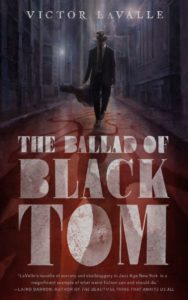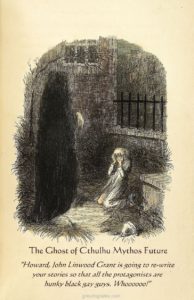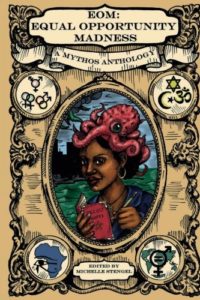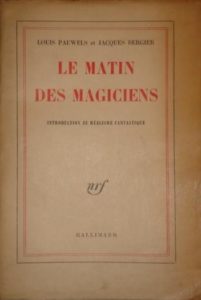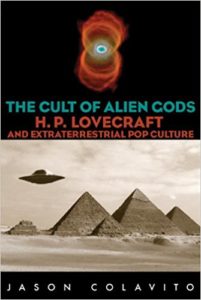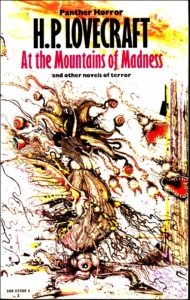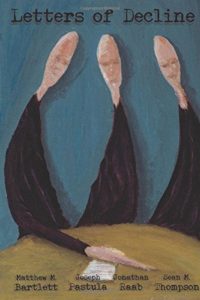In which I offer a rambling meditation on writing Lovecraftian fiction (or not), some comments on The Ballad of Black Tom by Victor LaValle, a new Lovecraftian anthology Equal Opportunities Madness from Otter Libris, and certain oddities from my own pen. And there are no rants, in case you wondered.
Speaking of rants, such is the nature of debate over H P Lovecraft and post- or neo-Lovecraftian fiction nowadays that a few words seem necessary first. I’m here for the writing, and to find out if it’s interesting or enjoyable. Yet merely raising some of the issues causes apoplexy in certain quarters, ranging from the cadre who revere Lovecraft as an unassailable saint, right across to those who decry everything about his work, his life and his abilities without reservation or filtering. It gets a bit intense.
Voices are raised as to which ‘side’ you are on, and even your right to comment. As far as I know, I belong to no cadre, camp or circle in the matter. As a teenager in the seventies and eighties I read Lovecraft (and his circle) avidly and repeatedly. I have all his work, a large selection of the post-Lovecraft anthologies and collections, and I even have a copy of the Dagon collection to hand for bathroom reading right now. And I’ve had enough strange fiction of my own published to reckon I dare offer the odd word.
Regarding HPL’s racism or the lack of women in his work, plenty has been examined elsewhere. In brief, I feel his phobias and prejudices fed his work, and helped form the ‘cosmic horror’ which is his legacy. As for his more appalling statements, views and phrases, I find them indicative of a troubled and flawed man, beating out at a world which wasn’t the one he wanted, in so many ways.
On a personal level, he was horribly racist at a time when an educated man or woman could have chosen not to be. No ‘everyone was like that back then’, please – if you read some of his letter comments on ‘the negro’, even into the last decade of his life, you’ll get the picture. Depressingly, of course, he wasn’t the only writer to hold such views, so I don’t shovel all my anger on to him in particular.
But if some of his prejudices are dreadful, some of his writing is fascinating. And if I write Lovecraftian fiction, which I do on a very occasional, ad hoc basis, I write it because his literary themes and tropes are interesting, unusual, or whatever. A legacy is not a command. But I’ll come back to that. Firstly, I want to mention Victor LaValle’s The Ballad of Black Tom.
LaValle and Red Hook
Let’s go straight in. Is this a good book? Is it interesting? Is it well written? Yes. And the fact that Victor LaValle is a black author adds additional relevance, though you don’t need to know that to appreciate it. Basically, the book relates to and reinterprets Lovecraft’s story The Horror at Red Hook, a tale which is a melting pot of Lovecraft’s worst views. Poor people and non-Whites, miscegenation, immigrants, etc.
“The population is a hopeless tangle and enigma; Syrian, Spanish, Italian, and negro elements impinging upon one another, and fragments of Scandinavian and American belts lying not far distant. It is a babel of sound and filth, and sends out strange cries to answer the lapping of oily waves at its grimy piers and the monstrous organ litanies of the harbour whistles. Here long ago a brighter picture dwelt, with clear-eyed mariners on the lower streets and homes of taste and substance where the larger houses line the hill.”
The Horror at Red Hook, H P Lovecraft
Which fits pretty much with Lovecraft’s description of New York, as he saw it when he lived there:
“an Asiatic hell’s huddle of the world’s cowed, broken, inartistic, and unfit.”
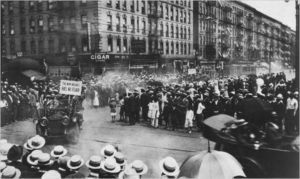
LaValle has said of HPL’s racism and views in this area:
“As an adult, I realize the point isn’t to separate Lovecraft’s writing from his prejudices, because his work is infused with, and informed by, those exact prejudices. In fact, his work wouldn’t be as interesting if he wasn’t such a profoundly prejudiced person. One of things he did incredibly well was to tap into a specific kind of fear—white, male, intellectual, upper class (if not wealthy any longer)—and turn that into a dreamy phantasmagoria that generations of readers and writers would eventually have to wander through. I like wrestling with that kind of thing rather than ignoring it.”
Interview, Nightmare Magazine October 2016
In LaValle’s work, the central character is a fine challenge to Lovecraft’s take – Tommy Tester, a black con-man trying to survive in 1920s New York. A real man, in a real world. Yet ironically that’s also one of the awkward aspects. Lavalle is so good at bringing out Tester, later known as Black Tom, and his environment, that you’re drawn into his reality.
“A little after 8 a.m., he left the apartment in his gray flannel suit. The slacks were cuffed but scuffed and the sleeves conspicuously short – fine fabric but frayed. This gave Charles a certain look, like a gentleman without a gentleman’s bank account. He picked the brown leather brogues with nicked toes, then the seal brown trooper hat instead of the fedora. The trooper hat’s brim showed its age and wear, and this was good for his hustle, too. Last, he took the guitar case, essential to complete the look. He left the guitar itself at home with his bedridden father. Inside, he carried only a yellow book, not much larger than a pack of cards. In the apartment, Charles Thomas Tester went by Charles. But on the street, everyone knew him as Tommy – Tommy Tester, always carrying a guitar case. This wasn’t because he aspired to be a musician. In fact, he could barely remember a handful of songs, and his singing voice might be described kindly as wobbly. His father, who had made a living as a bricklayer, and his mother, who spent her life working as a domestic, had loved music. Dad played guitar and mother could really stroll on a piano. It was only natural that Tommy Tester ended up drawn to performing. The only tragedy being that he lacked talent.”
The Ballad of Black Tom, Victor LaValle
For me, Charles ThomasTester himself is more interesting than the broader Lovecraftian plot. About halfway through, I wished that the whole thing was about him, his father, his associates, and that the ropes of Lovecraft might be let drift a little. Don’t get me wrong, it all works. It’s simply that I wanted even more of the life of Black Tom – the striking descriptions of a black person’s limits in that society, the finely-nuanced touches concerning Tester’s hustles and machinations, and his relationships. At one or two points I almost resented the fact that LaValle slid back to huge cosmic themes, not Tester’s experiences on the streets and the small, weird tasks he undertook.
It is an excellent read for anyone, and deserves to be recommended and shared. I do wish that it been longer (always a good sign, I suppose), and that it had less overtly Lovecraftian stuff in it. But then it wouldn’t be what Lavalle was trying to achieve, I guess.
If you want an intriguing, directly Lovecraftian story with genuine character, then you’re there. If you want a black protagonist who slides into Lovecraft’s horrifying cosmos, written by a black author, then you’re in the right place as well. LaValle has real talent, no doubt of that, and has done something strong.
You might be interested in the anthology Heroes of Red Hook, though I believe that this is only available in print directly from the publisher, Golden Goblin Press.
 http://www.goldengoblinpress.com/store/#!/Heroes-of-Red-Hook-Softcover/p/74102013
http://www.goldengoblinpress.com/store/#!/Heroes-of-Red-Hook-Softcover/p/74102013
Lovecraftian Leaps
Crawling back to where I was, there are many pitfalls in deliberately writing Lovecraftian fiction these days, even if race and gender characterisations are now considered in a more sane manner (we hope). The most common of these is that it lends itself to over-use of the Mythosian beings rather than the philosophies. There is a limit to how many things can be indescribable yet then frequently described, to the number of passing visits Cthulhu and Shub-Niggurath can make to your street before they become more like annoying neighbours.
“That Mr Tsathoggua has put his bins out early again, Fred, and blocked the drive.”
“Embodiment of cosmic evil, him. And he ate the cat last week.”
“Be fair, though. You never liked that cat anyway.”
It’s a problem when publishers and editors come up with a new anthology concept, and you’re an author who might want to slide in there. Amplify a time-honoured Lovecraft theme or trope in your own way? Shove Dagon back or forward a few centuries? Utterly subvert the old approaches? Or take a general weird story and slam a Mi-Go in it for luck. The Waltons, but with brain canisters. Good night, John Boy. Dzzz… crackle… dzzz.
For those of a far more analytic nature than myself, a recent paper in Palgrave Communications (by Dibyakusum Ray) discusses certain philosophical issues as to what is ‘Lovecraftian’. It even cites work by contemporary weird fiction authors such as Michael Wehunt, John Langan and Brian Evenson, as well as Thomas Ligotti.
“ ‘Lovecraftian’ is used rather casually in modern American mass-media. There was incongruity in Lovecraft’s own philosophy as well; lapses mostly owing to zeitgeist—a strong undercurrent of Orientalism including phonetic othering of Eastern sounding names, tendencies explicable now through postcolonial critical framework. The Lovecraftian, in short, inevitably loosened its grip over the unmaking of Rationalism, creating a space for anything involving a ‘mysterious’ eldritch—from creature to body horror—to identify itself to the moniker.”
Following the above statement, an example is given with regard to Mr Wehunt:
“Wehunt is Lovecraftian not because there is a general supernatural mystique in the majority of his stories, he is not Lovecraftian because of the ubiquitous decadent paranoia of the twilight of imperialism (Wehunt is, if anything, deeply concerned with the alienation of the increasingly bourgeois urbanity)—he is Lovecraftian by the dint of the inscrutable theoretical challenge his brand of supernatural imposes.”
The article is quite heavy, and I’m not sure if I agree with everything, but it’s worth a look (link at the end). I suspect that some of those cited would not consider many of their stories at all Lovecraftian, despite the retro-analysis. And it’s a shame that all of those cited seem to be white male authors.
Falling into the Sandpit
I’ve faced the question of writing identifiable Lovecraftian fiction four or five times in the last couple of years, and had many doubts about where I was heading. As a reader, I can enjoy the odd lumbering, squirming monstrosity, but as a writer I find it harder to go there. I’m perhaps closer in sympathy to Wehunt, Griffin and others.
My broad feeling is that if you actively choose to go Lovecraftian, you search out what is truly monstrous, not the monsters. You consider scenarios and psychologies which give access to exploration of sanity, reality and the rest by real people rather than cutouts. I’m a ‘people first’ kind of chap.
So, to give concrete examples – in ‘Messages’, my story for the Cthulhusattva anthology from Martian Migraine, the tale is about the psychology of a mother and daughter who follow Nyarlathotep, not blindly but with clear intent. They have reasons, and reason. They are people on a different path. If anything, they despise the classic Lovecraftian cultists as the ill-informed and unbalanced wannabes that they are.
We who serve the Messenger do not judge by appearances. Schalck and McConnell are ugly inside, small-minded and self-serving. McConnell even looks the part due to the plastic surgery which has widened his mouth and thickened his lips, homage to his professed belief in Dagon. He is wholly human, without any taint of the reef, which must sting him.
In ‘Whiskey, Beans and Dust’, a Mamma Lucy story, the true challenge is not between Mythosian powers, but between the mind-set of an old conjure-woman and a sect of hill-folk.
“You don’t know better, hoodoo woman. A bag of roots and junk in a dress pocket; silver strings on a banjo – and prayers to a God who never was.” He sketched a twisted sign with his left hand. “Our End Times will come, and all will be scoured clean by the wind from the stars.”
“This happenin’ soon?”
“We are not told.”
“So, could be awhile yet, time to set a kettle on the stove, maybe plant some corn.”
“You mock us.”
Mamma Lucy laughed. “Sure as spit, I do.”
Equal Horrors
And then there’s ‘With the Dark and the Storm’, just out in the anthology Equal Opportunities Madness from Otter Libris. I now realise that in terms of any of my tales brushing on Lovecraft, this is the first time I deliberately wrote the ‘heroes’ as non-white characters. In other cases, the protagonists just arrived in my head, whatever colour or gender they were.
This project, however, was proposed as a slightly tongue-in-cheek jab, not so much at Lovecraft as at the typical protagonists of his stories – and many subsequent Lovecraftian tales.
“In the depths of the cosmos there is madness to be found and there are stories to be told… The Elder Gods, Cthulhu, Nyarlethotep, and the like have a taste for fear, for madness, for flesh… But over the years they have grown bored with the taste of the standard straight, white male so often portrayed in the tales of the Mythos. Like a human being with a hankering for Thai after a steady diet of steak and potatoes, the Gods of the Mythos are craving something different…”
I almost didn’t go there, but due to a falling out with Edgar Wallace over his African stories, I wrote a story which was a riposte to the colonial white protagonists of Wallace and the cultist white protagonists of Lovecraft. A story of Igbo villagers in 1920s colonial Nigeria, facing yet more disruption to their way of life – and dealing with it on their own.
The dibia looked up. He was thin and naked except for a dirty white cloak which lay over one shoulder. The cloak covered his lap and went down to the torn matting on the ground.
“Nduka son of Onodugo. I did not think to see you.”
“I did not think to come.” Nduka sat cross-legged opposite the dibia. “Until today. But a dead man once told me that you speak to the gods.”
“It has been known.” The dibia smiled, showing broken teeth.
Equal Opportunities Madness contains the following stories:
Scars of a Certain Value by Christine Lucas
The Horror of the Atoll by DJ Tyrer
With the Dark and the Storm by John Linwood Grant
The Sisters Derleth by Michelle D. Sonnier
A Singular Event, in Several Courses by Kris Dikeman
The Bath, Bottle, and Bar’nyeth Party by Lizz-Ayn Shaarawi
Innsmouth Blues by Jean Roberta
The Black Magnolia on the Bank of the Night’s River by Gordon White
The Thing at Akeley Farm by A.Z. Louise
But Who Can Catch Leviathan? by Chris Pearce
North Bronx Nightmare by Andrea Stanet
The P’tulpa Cult by Daniel S. Duvall
Golem by Jennifer R. Povey
Dreidel of Dread: The Very Cthulhu Chanukah by Alex Shvartsman
It’s available now in print on Amazon, and as an ebook from Smashwords.
https://www.smashwords.com/books/view/738264
The fact is that the bulk of my work doesn’t draw on old HPL’s legacy in any immediate way, although I have no doubts about his influence on the field of weird fiction in general. And I don’t expect to be writing Lovecraftian pieces that often, but it’s an interesting place to visit now and then.
For reference, that interview with Victor Lavalle can be found here:
http://www.nightmare-magazine.com/nonfiction/interview-victor-lavalle/
And the philosophical article mentioned above is, in full, Ray D (2017) The true-weird and the dreadful ‘large’: post millennium American horror literature. Palgrave Communications. 3:17080 doi: 10.1057/palcomms.2017.80
https://www.nature.com/articles/palcomms201780
Phew. Next time, anything – there’s a lot going on. And in September, more lurchers, to celebrate the second anniversary of Lurchers for Beginners…
